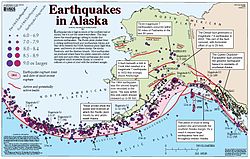1585 Aleutian Islands earthquake
The 1585 Aleutian Islands earthquake is the presumed source of a tsunami along the Sanriku coast of Japan on 11 June 1585, known only from vague historical accounts and oral traditions.
A megathrust earthquake on the Aleutian subduction zone in the North Pacific Ocean was hypothesized as the tsunami's source.
In 1586, a legend emerged in Japan describing a wave measuring up to two meters which struck near Tokura village in the Motoyoshi District of Miyagi Prefecture.
[1] Surviving historical accounts from the period are ambiguous or incomplete, which has made it difficult to identify the tsunami's specific origin.
Historical descriptions of the tsunami that struck locally in Callao reported two very different heights, 3.7 and 24 metres (12 and 79 ft).
Because the Tenshō earthquake occurred in 1586, the Sanriku tsunami was incorrectly dated to 1586, coincidentally matching the Peru quake as well.
The allochthonous deposit, consisting of stones and fragmented aeolianite were sourced from a distant location, confirming the occurrence of a major tsunami-like event in the Hawaiian Islands.
The state of these boulders, cobbles, gravel, and sand, severely fractured and angular, concluded that they formed during one intense event.
In a 2014 study of the site led by Rhett Butler, researchers from the University of Hawaiʻi at Mānoa, National Tropical Botanical Garden and Pacific Tsunami Warning Center found the same deposit, 0.8 meters thick.
The layer deposited in the sinkhole was sourced by a tsunami much larger than anything generated by the largest Pacific earthquakes.
The Sanriku orphan tsunami may have been associated with deposited materials in near Sendai City, Miyagi, which could not be explained by nearby earthquakes.
[10][13] Inscriptions on a monument at Tokura village said that the tsunami struck the northeastern coast of Japan with a height of 1 to 2 meters.
[10] There is paleotsunami evidence in nine locations in Oregon, Washington and British Columbia to show that a tsunami occurred near the Cascadia subduction zone prior to the 1700 event.


